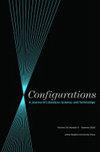《深度时间计算:未来思维如何帮助地球》作者:文森特·亚伦蒂
IF 0.3
4区 文学
Q3 HISTORY & PHILOSOPHY OF SCIENCE
引用次数: 1
摘要
(p。193)。这样的伦理仍然植根于对“生物之间不可逾越的距离”(第195页)的尊重,我们可以看到,Traisnel深刻地指出,在uexk本文章由计算机程序翻译,如有差异,请以英文原文为准。
Deep Time Reckoning: How Future Thinking Can Help Earth Now by Vincent Ialenti (review)
(p. 193). Such an ethics remains rooted in a respect for the “unbridgeable distance between living beings” (p. 195), one that we can see, Traisnel insightfully notes, in the ethology of Uexküll. Traisnel’s theory of capture and his interest in genre provoke two important questions that future work must consider. While Traisnel tracks the afterlives of capture in the present-day factory farming industry, one wonders about how this theory of capture might apply to the proliferation of pets at the turn of the century (many of whom were and are literally “captive,” as it were, in houses); at the end of the nineteenth century, the pet industry began to burgeon into existence and thereby dramatically reconfigured human relationships with animals. How, then, does capture—“from capere, meaning to seize with one’s hands,” as Traisnel reminds us (p. 18)—apply to these domesticated creatures raised by hand, as it were? Traisnel’s book also provokes questions about the genre of poetry, most especially when one arrives at the conclusion and reads the haunting epigraph from Dickinson: “I held it so tight that I lost it / Said the Child of the Butterfly / Of Many a vaster Capture / That is the Elegy —.” If Hawthorne’s “poetic” speculations resist a paradigm of capture, then how did poems in the nineteenth century resist and perhaps participate in this same paradigm? Future answers to these questions must rely on the help of Traisnel’s remarkable new book.
求助全文
通过发布文献求助,成功后即可免费获取论文全文。
去求助
来源期刊

Configurations
Arts and Humanities-Literature and Literary Theory
CiteScore
0.50
自引率
0.00%
发文量
33
期刊介绍:
Configurations explores the relations of literature and the arts to the sciences and technology. Founded in 1993, the journal continues to set the stage for transdisciplinary research concerning the interplay between science, technology, and the arts. Configurations is the official publication of the Society for Literature, Science, and the Arts (SLSA).
 求助内容:
求助内容: 应助结果提醒方式:
应助结果提醒方式:


